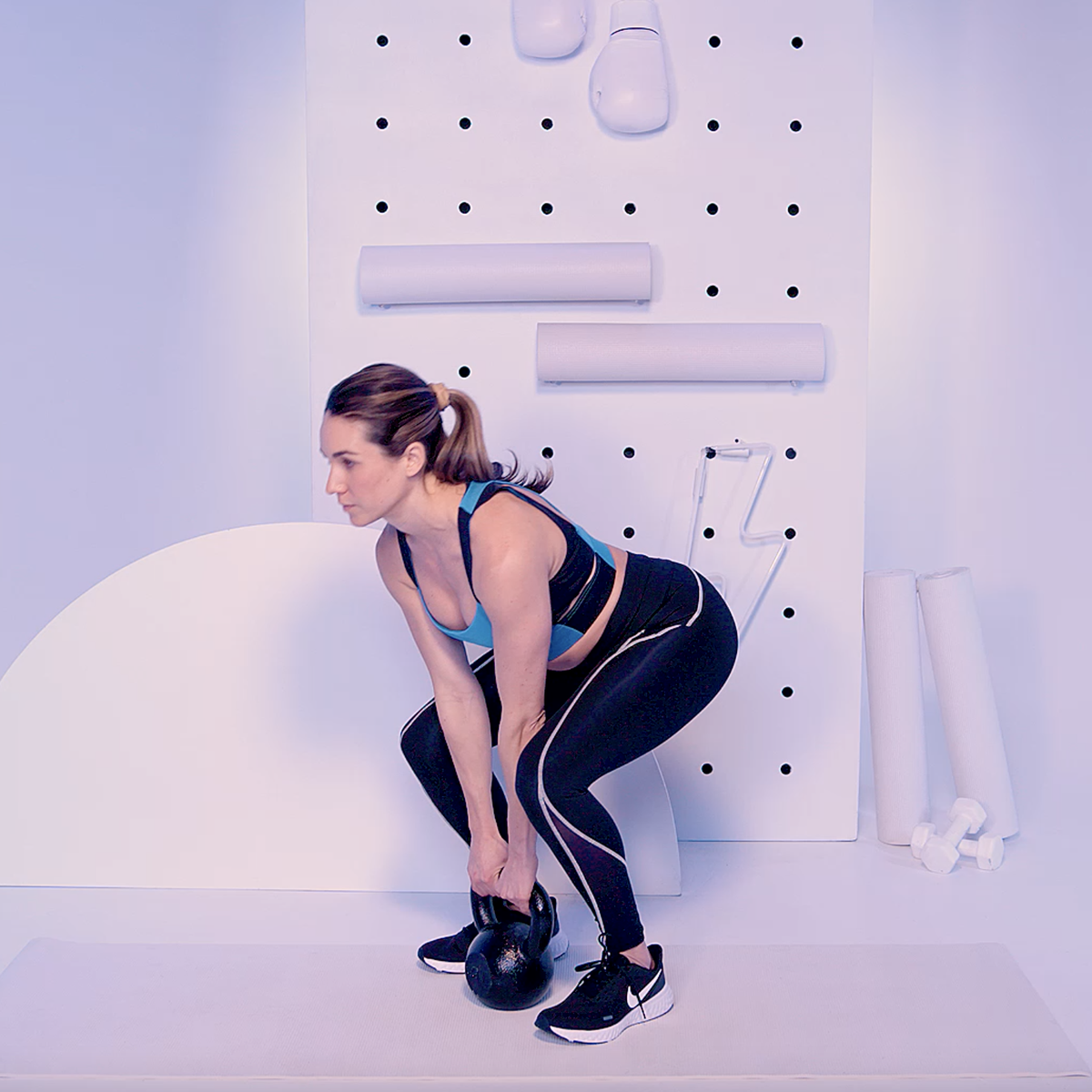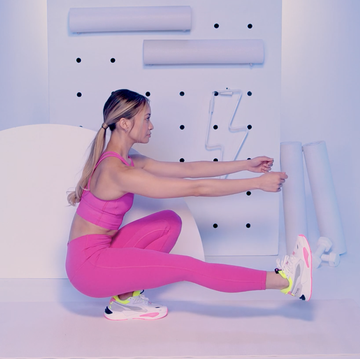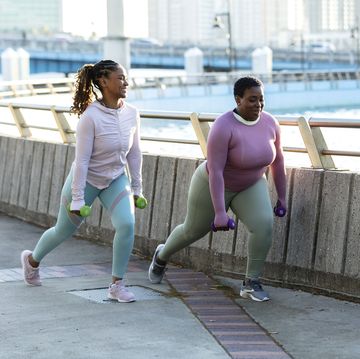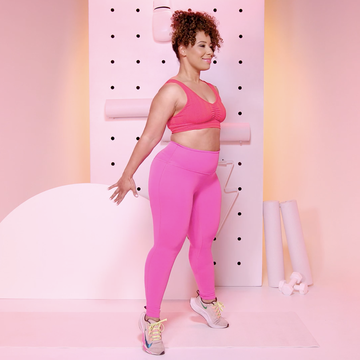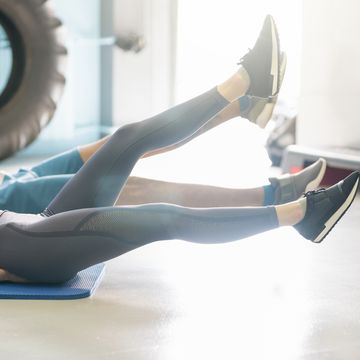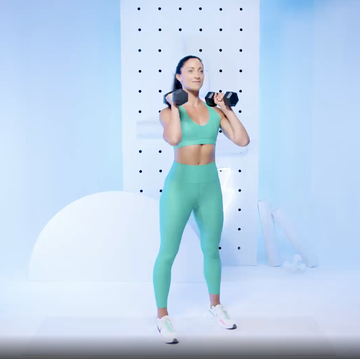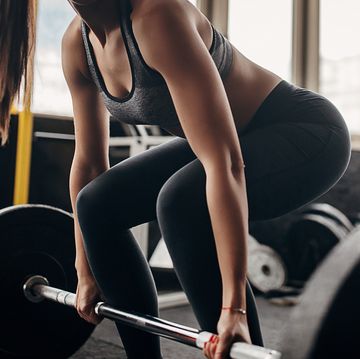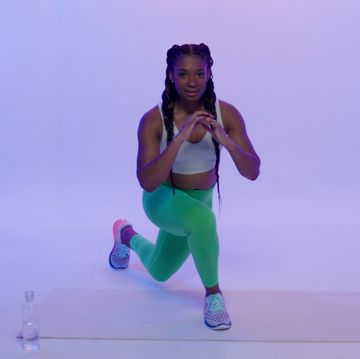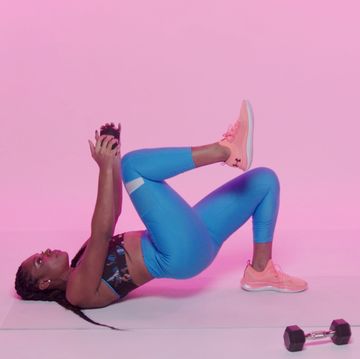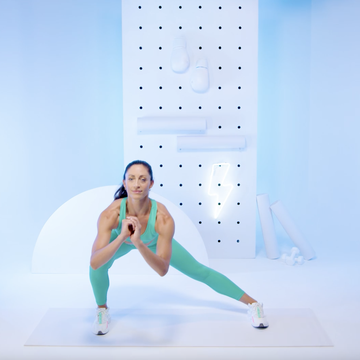My leg days are incomplete without a few sets of squats. While I don't have a squat rack at home (#homegymgoals), I do have kettlebells. And, whoa, can they level up a squat right at home.
Yup, kettlebells are awesome for squatting (and swings, Romanian deadlifts, Turkish get-ups, and beyod). Because of the compact shape, people are generally able to lift more weight using a kettlebell, according to Amanda Hudock Hoffman, CPT, who is a certified kettlebell specialist.
Meet the expert: Amanda Hudock Hoffman, CPT, is a certified personal trainer based in Ohio. She leads kettlebell programs and also boasts an RKC (Russian Kettlebell Challenge certification).
More From Women's Health

Plus, she adds, due to the way they’re holding the weight, many people can sit deeper into a goblet squat with a kettlebell than they can while doing, say, a barbell squat. That can make a big difference in your gains. Your lower bod will def feel the burn, but that's just the beginning.
Ready to get your kettlebell squat on? Here's everything you need to know about kettlebell squats, from step-by-step form instructions to picking the perfect bell weight to variations fit for pros according to experts.
What muscles do kettlebell squats work?
Kettlebell squats recruit muscles all over: legs, back, arms, shoulders, and core.
“Primarily, you’re working the quads and the glutes,” Hoffman says. That, she notes, is pretty similar to any other kind of squat. But the kettlebell targets additional muscles. Because you’re holding the weight out, you’re working your back, arms, and shoulders, too, Hoffman explains.
Plus, your core is engaged to keep you upright. “If you think of yourself holding a goblet position with a kettlebell and you’re in the standing position of the squat, it’s essentially the same as a forearm plank,” she says.
How To Do Kettlebell Squats
Even if you’ve already mastered perfect squat form, don’t skip this section. Adding weight with a bell means there are a few more form tips to keep in mind during this move, according to Hoffman.
How to:
- Line yourself up with the kettlebell on the ground. How you get in and out of the exercise is an important part of staying injury-free. Start with the kettlebell right under your body, lining up the handle with your ankle bones so that you’re in a natural squatting position (this protects your low back by engaging your glutes and lats).
- Grab the kettlebell on top of the handle. Shift your weight so that about 60 percent rests in your heels and 40 percent rests in your toes as you lift the bell up. Make sure you load your glutes instead of your back. Allow your hands to slide to the sides of the handle.
- Land with the bell’s handle at chin level. Don’t let it rest on your body, because you want your back and core working to hold it up.
- Lower into your hips. With your toes pointing straight ahead, allow your knees to soften and drive forward as you drop. Inhale as you lower down for 1 to 3 seconds, keeping your gaze forward and your torso upright. (And BTW, squatting to parallel and below parallel are both correct.)
- Hold for 2 to 3 seconds at the bottom. Then, press your feet into the ground to return to standing, exhaling for 1 to 3 seconds. That's 1 rep.
Pro tip: Stand with your feet at hips distance, then jump three times. Wherever your feet land, Hoffman says, that’s your squat stance sweet spot.
Common Kettlebell Squat Mistakes
There are a couple common errors Hoffman sees during the move. You’ll want to avoid these kettlebell squat missteps in order to stay safe and get the most out of it.
You lean too far forward. This is called hinging. “When you squat, think of your torso almost like an elevator,” Hoffman says. “It goes up and down, but it doesn’t go side to side.” The goal of the squat, she explains, is to work your quads and glutes. When you hinge forward, it takes some of the work away from the quads, and can also load the low back and potentially lead to pain.
You might find yourself hinging if your ankles aren’t mobile, according to Hoffman Luckily, there’s an easy fix: Elevate your heels, making sure both feet are propped evenly, she suggests. You can use barbell plates for this, Hoffman notes, or even cookbooks and textbooks. (And if you really want to go all-in, you can purchase actual squat wedges.)
Your knees aren't on track. If your knees cave in or come too far out, you can injure your joints, Hoffman explains. She notes that there are a few reasons this might happen, like if you’re taller and your stance is too narrow. But often, she says, this occurs due to lack of strength, in which case she recommends switching to bodyweight and potentially even using your hands to pull your knees in or press them out so that they’re aligned with your second or third toe.
Your feet are wobbling. Your shoes could be the prob, per Hoffman. She recommends squatting barefoot or in flat training shoes (not running shoes!) to avoid unstable feet.
Now, if you’re still struggling with form, you might want to see a trainer for personalized help, Hoffman says. Everyone is different, she notes: You might be hinging forward because you have low ankle mobility, but it also could result from tight hips or an injury you don’t realize is affecting your squat. If you’re concerned about your form, it’s 100% worth it to work with a pro, she says.
How To Add Kettlebell Squats To Your Workout
- Beginners: If you’re just starting out with exercise, Hoffman suggests adding kettlebell squats in once a week.
- Intermediate: If you’ve got more experience (as in, you’ve been working out for at least six months), go ahead and level up to twice a week, she says.
- All levels: You shouldn’t save these for the end of your workout if your goal is to work a little heavier or build a good foundation, Hoffman adds. “You don’t want to do 30 minutes of cardio and then squat, because you’ll be tired,” she says. (Still, be sure to warm up first, activating the muscles and joints you’ll need to use with movements like bodyweight squats, runner’s lunges, and planks.)
How Much Weight To Kettlebell Squat
The best kettlebell weight depends on your workout goals. “You can have three different kettlebell sizes,” Hoffman says, “and they can all be beneficial for that squat depending what your goal is.” On some days, she adds, you might work really heavy with lower reps and on others you might go for a lighter weight and extra reps.
The right kettlebell weight for each goal:
- If you’re looking to build a foundation and muscular endurance, do 10 to 15 reps with a weight that allows you to feel like you could maybe do five more.
- To build muscle size once you’ve got some endurance, do six to 15 reps with a heavier weight that allows you to feel like you could maybe do two to four more.
- To build strength, do up to five reps with a weight that feels very heavy for you. You should feel like your form would suffer if you attempted one more.
In general, Hoffman recommends picking out a good quality kettlebell made of cast iron with a powder coat. “It’s worth it to invest in the cast iron bell,” she says, adding that they’ll last longer and will be more comfortable to use.
A good starter pack might include three bells: 18, 26, and 35 pounds, Hoffman says. (But take note: KB’s are often sold in kilos, she says. That's a starter set of 8, 12, and 16 kilos.) When you incorporate them into your squats, make sure to start light, Hoffman advises. Try a few reps with your chosen weight, focusing on your form, she adds.
Kettlebell Squat Variations
There are a few different ways to level up your kettlebell squats once you’ve nailed the basics. So, when you’re ready (and perhaps a little bored with the movement you’ve been perfecting), try one of these:
1. Time Under Tension Kettlebell Squat
If you want to challenge yourself in the goblet squat but aren’t quite ready to increase your weight, Hoffman suggests amping up your time under tension (stay in the squat longer). Lower for 5 seconds, hold at the bottom for 5 seconds, then stand up for 5 seconds. You can also change up how you’re holding the bell. Holding it up higher (in line with your face instead of your chin) will challenge your muscles more.
2. Kettlebell Front Squat
You can also try an entirely new variation, like the kettlebell front squat (with or without the press as shown). This move, Hoffman says, is when you have two kettlebells in the front rack position. Hold them up and resting on vertical forearms, keep your elbows by your ribcage, and maintain slight wrist flexion (think: knuckles up), she explains.
3. Offset Kettlebell Squat
This squat variation is very similar to the front squat, Hoffman notes, but you’re doing it with just one kettlebell. This variation, she says, is great for evening out any imbalances you may have (if, for instance, one side is stronger than the other). Plus, the offset load adds a ton of extra core work. “Single-arm front squats are secret core,” Hoffman says. “I promise [they] will give you so much more than a sit-up.”
Erin Warwood is a San Francisco-based writer, runner, and sparkling water enthusiast. She holds a B.B.A. from the University of Notre Dame and an M.S. in journalism from Northwestern University. In her free time, you can find her watching Survivor, trying new Peloton workouts, and reading Emily Giffin novels. Her ultimate goal: become a morning person.

Jennifer Nied is the fitness editor at Women’s Health and has more than 10 years of experience in health and wellness journalism. She’s always out exploring—sweat-testing workouts and gear, hiking, snowboarding, running, and more—with her husband, daughter, and dog.
